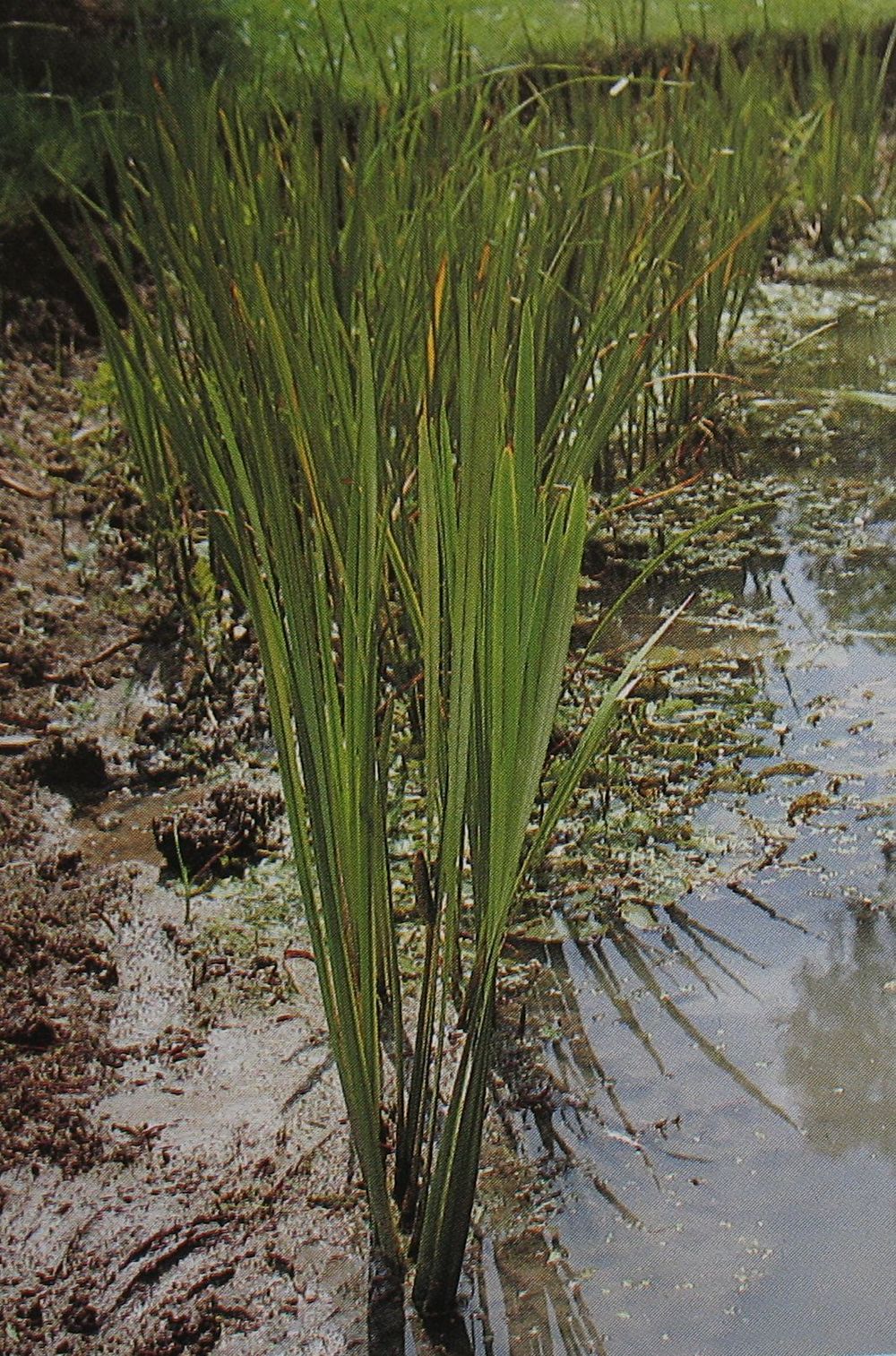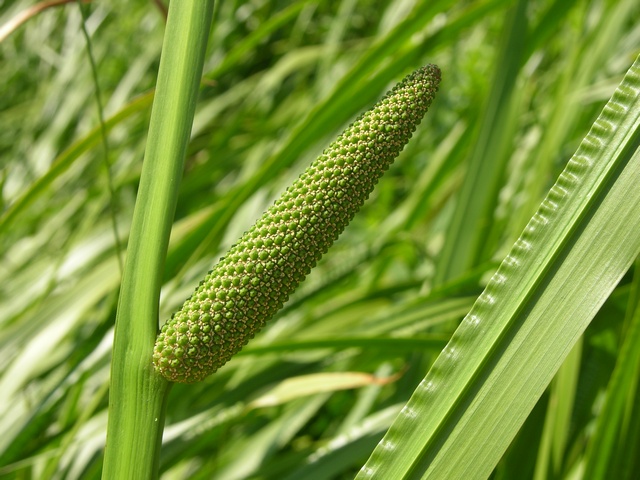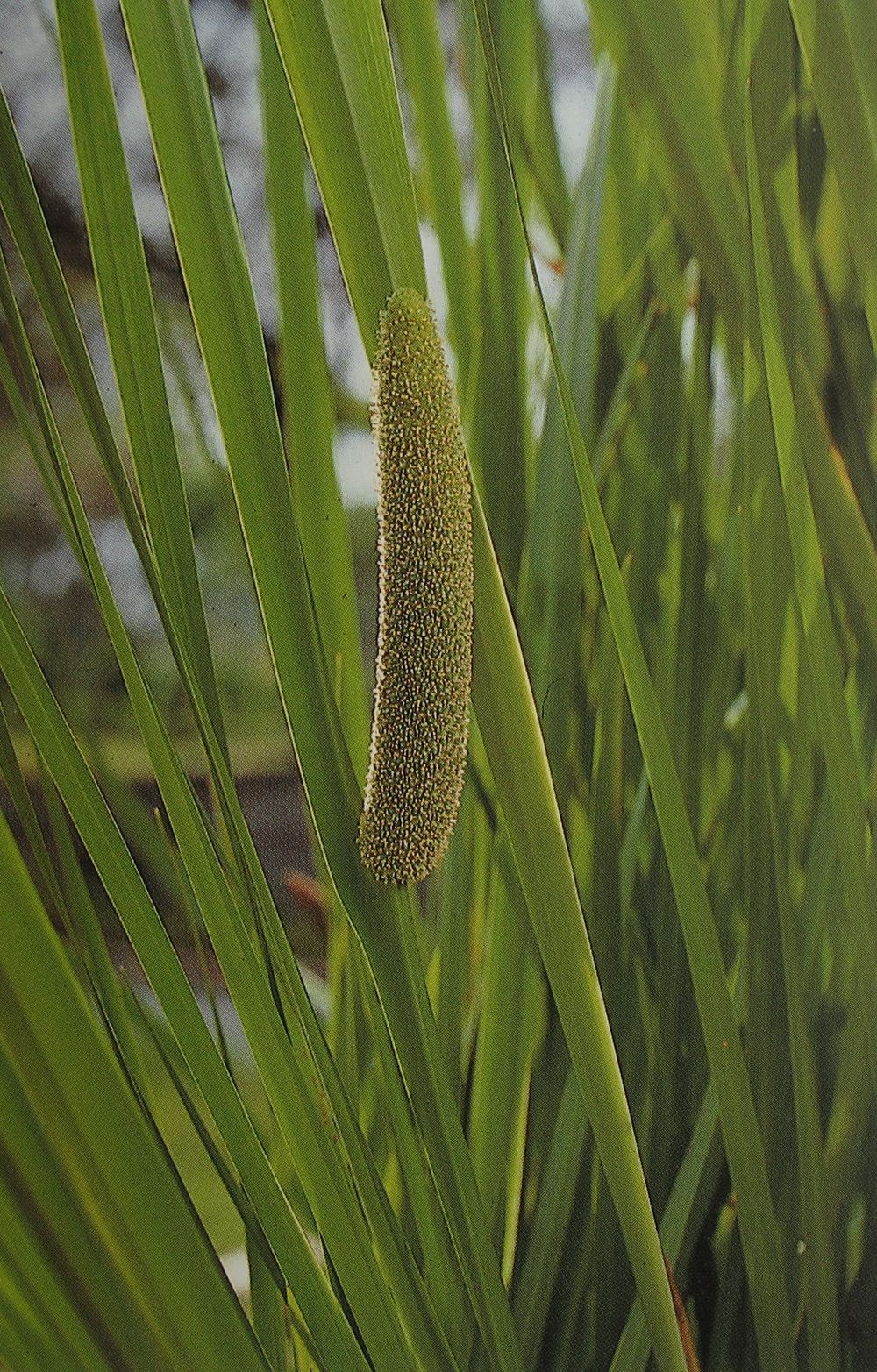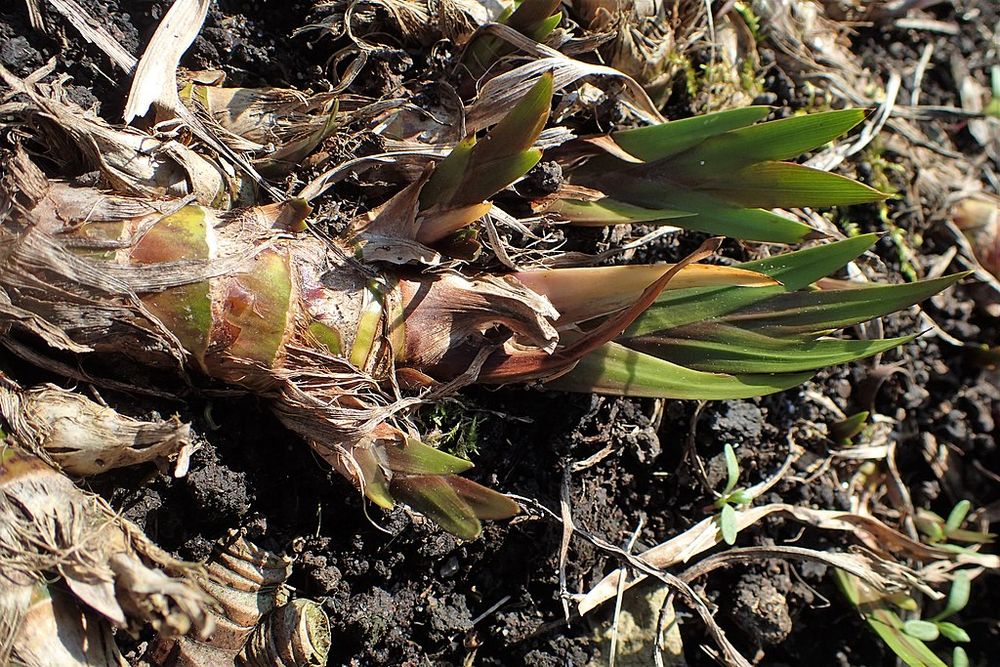The Sweet Flag has been introduced to Europe from India so long ago that the exact period is uncertain. Some suggest it was spread around the 12th century by Mongol horsemen who used it to freshen their water bottles, while others believe it was brought from India to Europe in the 16th century. What is certain is that its scientific name comes from the Greek: Acorus, meaning “plant with aromatic root,” and calamus, meaning “reed.”
Sweet Flag is a perennial herb that grows in water or very humid areas, reaching a height of 50 cm to 1 meter. Its leaves emerge from a long jointed rhizome, and they are linear and sword-shaped, sheathing. A very long, upright, persistent leafy spathe supports a large spike entirely covered with very small, tightly packed, yellowish hermaphroditic flowers. The fruit, which rarely forms in temperate climates, is a small capsule containing 2 to 3 seeds.
This aromatic plant is used in cooking in India and China but is especially valued in medicine in both Asia and Europe. In cooking, similar to galangal with which it has sometimes been confused, the rhizome serves as a condiment in sweet or savory dishes, known for its bitter taste. In medicine, it is generally recommended to aid digestion, but the list of its various uses is extensive.
In Laos, Sweet Flag is called Acorus (hang khao nam or vane nam), and we know that all vane plants are important medicinal or magical plants. The infused rhizome of vane nam is believed to have strengthening, diuretic, and aphrodisiac properties. In Vietnam and China, it is a remedy for fatigue and memory weakness. In Thailand, it is also said that this rhizome has interesting emetic properties in case of poisoning. Among the Hmong people, the plant is used to cook chicken, hence its name, pawj qaib, meaning “chicken.”
Currently in Europe, Sweet Flag is used in herbal medicine for its stomachic properties, but it is experiencing a renewed interest from pharmaceutical laboratories. Some believe it could have anti-diabetic and anti-cancer virtues, while others recognize potential side effects on the liver and carcinogenic activity. Therefore, it is more prudent to plant vane nam in your garden, as the Laotians, especially in the North of the country, do for its delightful scent, reminiscent, they say, of rice, and considered an omen of prosperity.
Il y a tellement longtemps que ce Roseau a été introduit d’Inde en Europe que l’époque en est incertaine; pour les uns il aurait été propagé vers le XII° siècle par les cavaliers mongols qui en rafraîchissaient l’eau de leur gourde, pour d’autres, il aurait été amené de l’Inde en Europe au XVI° siècle. Ce qui est certain c’est que son nom scientifique vient du grec: Acorus d’”akoros“, “plante à racine aromatique” et calamus de “kalamos“, “Roseau ».
Le roseau odorant est une herbe vivace poussant dans l’eau ou dans les terrains très humides à une hauteur de 50cm à 1 mètre. Ses feuilles partent d’un long rhizome articulé; elles sont linéaires en forme de glaive, engainantes. Une spathe foliacée très longue, dressée, persistante soutient un gros épi entièrement recouvert de très petites fleurs hermaphrodites très serrées, jaunâtres. Le fruit qui ne se forme que rarement en climat tempéré est une petite capsule contenant 2 à 3 graines.
Cette plante aromatique est employée en cuisine en Inde et en Chine mais surtout en médecine aussi bien en Asie qu’en Europe. En cuisine, un peu comme le galanga avec lequel elle a parfois été confondue, le rhizome sert de condiment dans les plats sucrés ou salés; sa saveur est réputée amère. En médecine elle est généralement recommandée pour faciliter la digestion mais la liste de ses emplois variés est fastidieuse.
Au Laos on nomme l’Acorus hang khao nam ou vane nam et nous savons bien que tous les vane sont des plantes médicinales ou magiques importantes. Le rhizome de vane nam en infusion aurait des propriétés fortifiantes, diurétiques et aphrodisiaques; au Viêt Nam et en Chine, c’est un remède contre la fatigue et la faiblesse de la mémoire; en Thaïlande on dit aussi que ce rhizome a des propriétés vomitives intéressantes en cas d’empoisonnement. Chez les Hmong la plante est utilisée pour faire cuire le poulet d’où son nom, pawj qaib, qui signifie « poulet »
Actuellement en Europe, on utilise le roseau odorant en phytothérapie pour ses propriétés stomachiques; mais il connaît un regain d’intérêt de la part des laboratoires pharmaceutique; certains pensent qu’il pourrait avoir des vertus antidiabétiques et anti cancéreuses, quand d’autres reconnaissent des effets secondaires sur le foie et une activité cancérigène !
Il est plus prudent donc de planter vane nam dans son jardin, comme le font les Lao surtout dans le Nord du pays, pour sa délicieuse odeur qui, nous dit-on, rappelle celle du riz et est un présage de prospérité.




The Sweet Flag has been introduced to Europe from India so long ago that the exact period is uncertain. Some suggest it was spread around the 12th century by Mongol horsemen who used it to freshen their water bottles, while others believe it was brought from India to Europe in the 16th century. What is certain is that its scientific name comes from the Greek: Acorus, meaning “plant with aromatic root,” and calamus, meaning “reed.”
Sweet Flag is a perennial herb that grows in water or very humid areas, reaching a height of 50 cm to 1 meter. Its leaves emerge from a long jointed rhizome, and they are linear and sword-shaped, sheathing. A very long, upright, persistent leafy spathe supports a large spike entirely covered with very small, tightly packed, yellowish hermaphroditic flowers. The fruit, which rarely forms in temperate climates, is a small capsule containing 2 to 3 seeds.
This aromatic plant is used in cooking in India and China but is especially valued in medicine in both Asia and Europe. In cooking, similar to galangal with which it has sometimes been confused, the rhizome serves as a condiment in sweet or savory dishes, known for its bitter taste. In medicine, it is generally recommended to aid digestion, but the list of its various uses is extensive.
In Laos, Sweet Flag is called Acorus (hang khao nam or vane nam), and we know that all vane plants are important medicinal or magical plants. The infused rhizome of vane nam is believed to have strengthening, diuretic, and aphrodisiac properties. In Vietnam and China, it is a remedy for fatigue and memory weakness. In Thailand, it is also said that this rhizome has interesting emetic properties in case of poisoning. Among the Hmong people, the plant is used to cook chicken, hence its name, pawj qaib, meaning “chicken.”
Currently in Europe, Sweet Flag is used in herbal medicine for its stomachic properties, but it is experiencing a renewed interest from pharmaceutical laboratories. Some believe it could have anti-diabetic and anti-cancer virtues, while others recognize potential side effects on the liver and carcinogenic activity. Therefore, it is more prudent to plant vane nam in your garden, as the Laotians, especially in the North of the country, do for its delightful scent, reminiscent, they say, of rice, and considered an omen of prosperity.
Il y a tellement longtemps que ce Roseau a été introduit d’Inde en Europe que l’époque en est incertaine; pour les uns il aurait été propagé vers le XII° siècle par les cavaliers mongols qui en rafraîchissaient l’eau de leur gourde, pour d’autres, il aurait été amené de l’Inde en Europe au XVI° siècle. Ce qui est certain c’est que son nom scientifique vient du grec: Acorus d’”akoros“, “plante à racine aromatique” et calamus de “kalamos“, “Roseau ».
Le roseau odorant est une herbe vivace poussant dans l’eau ou dans les terrains très humides à une hauteur de 50cm à 1 mètre. Ses feuilles partent d’un long rhizome articulé; elles sont linéaires en forme de glaive, engainantes. Une spathe foliacée très longue, dressée, persistante soutient un gros épi entièrement recouvert de très petites fleurs hermaphrodites très serrées, jaunâtres. Le fruit qui ne se forme que rarement en climat tempéré est une petite capsule contenant 2 à 3 graines.
Cette plante aromatique est employée en cuisine en Inde et en Chine mais surtout en médecine aussi bien en Asie qu’en Europe. En cuisine, un peu comme le galanga avec lequel elle a parfois été confondue, le rhizome sert de condiment dans les plats sucrés ou salés; sa saveur est réputée amère. En médecine elle est généralement recommandée pour faciliter la digestion mais la liste de ses emplois variés est fastidieuse.
Au Laos on nomme l’Acorus hang khao nam ou vane nam et nous savons bien que tous les vane sont des plantes médicinales ou magiques importantes. Le rhizome de vane nam en infusion aurait des propriétés fortifiantes, diurétiques et aphrodisiaques; au Viêt Nam et en Chine, c’est un remède contre la fatigue et la faiblesse de la mémoire; en Thaïlande on dit aussi que ce rhizome a des propriétés vomitives intéressantes en cas d’empoisonnement. Chez les Hmong la plante est utilisée pour faire cuire le poulet d’où son nom, pawj qaib, qui signifie « poulet »
Actuellement en Europe, on utilise le roseau odorant en phytothérapie pour ses propriétés stomachiques; mais il connaît un regain d’intérêt de la part des laboratoires pharmaceutique; certains pensent qu’il pourrait avoir des vertus antidiabétiques et anti cancéreuses, quand d’autres reconnaissent des effets secondaires sur le foie et une activité cancérigène !
Il est plus prudent donc de planter vane nam dans son jardin, comme le font les Lao surtout dans le Nord du pays, pour sa délicieuse odeur qui, nous dit-on, rappelle celle du riz et est un présage de prospérité.








The Sweet Flag has been introduced to Europe from India so long ago that the exact period is uncertain. Some suggest it was spread around the 12th century by Mongol horsemen who used it to freshen their water bottles, while others believe it was brought from India to Europe in the 16th century. What is certain is that its scientific name comes from the Greek: Acorus, meaning “plant with aromatic root,” and calamus, meaning “reed.”
Sweet Flag is a perennial herb that grows in water or very humid areas, reaching a height of 50 cm to 1 meter. Its leaves emerge from a long jointed rhizome, and they are linear and sword-shaped, sheathing. A very long, upright, persistent leafy spathe supports a large spike entirely covered with very small, tightly packed, yellowish hermaphroditic flowers. The fruit, which rarely forms in temperate climates, is a small capsule containing 2 to 3 seeds.
This aromatic plant is used in cooking in India and China but is especially valued in medicine in both Asia and Europe. In cooking, similar to galangal with which it has sometimes been confused, the rhizome serves as a condiment in sweet or savory dishes, known for its bitter taste. In medicine, it is generally recommended to aid digestion, but the list of its various uses is extensive.
In Laos, Sweet Flag is called Acorus (hang khao nam or vane nam), and we know that all vane plants are important medicinal or magical plants. The infused rhizome of vane nam is believed to have strengthening, diuretic, and aphrodisiac properties. In Vietnam and China, it is a remedy for fatigue and memory weakness. In Thailand, it is also said that this rhizome has interesting emetic properties in case of poisoning. Among the Hmong people, the plant is used to cook chicken, hence its name, pawj qaib, meaning “chicken.”
Currently in Europe, Sweet Flag is used in herbal medicine for its stomachic properties, but it is experiencing a renewed interest from pharmaceutical laboratories. Some believe it could have anti-diabetic and anti-cancer virtues, while others recognize potential side effects on the liver and carcinogenic activity. Therefore, it is more prudent to plant vane nam in your garden, as the Laotians, especially in the North of the country, do for its delightful scent, reminiscent, they say, of rice, and considered an omen of prosperity.
Il y a tellement longtemps que ce Roseau a été introduit d’Inde en Europe que l’époque en est incertaine; pour les uns il aurait été propagé vers le XII° siècle par les cavaliers mongols qui en rafraîchissaient l’eau de leur gourde, pour d’autres, il aurait été amené de l’Inde en Europe au XVI° siècle. Ce qui est certain c’est que son nom scientifique vient du grec: Acorus d’”akoros“, “plante à racine aromatique” et calamus de “kalamos“, “Roseau ».
Le roseau odorant est une herbe vivace poussant dans l’eau ou dans les terrains très humides à une hauteur de 50cm à 1 mètre. Ses feuilles partent d’un long rhizome articulé; elles sont linéaires en forme de glaive, engainantes. Une spathe foliacée très longue, dressée, persistante soutient un gros épi entièrement recouvert de très petites fleurs hermaphrodites très serrées, jaunâtres. Le fruit qui ne se forme que rarement en climat tempéré est une petite capsule contenant 2 à 3 graines.
Cette plante aromatique est employée en cuisine en Inde et en Chine mais surtout en médecine aussi bien en Asie qu’en Europe. En cuisine, un peu comme le galanga avec lequel elle a parfois été confondue, le rhizome sert de condiment dans les plats sucrés ou salés; sa saveur est réputée amère. En médecine elle est généralement recommandée pour faciliter la digestion mais la liste de ses emplois variés est fastidieuse.
Au Laos on nomme l’Acorus hang khao nam ou vane nam et nous savons bien que tous les vane sont des plantes médicinales ou magiques importantes. Le rhizome de vane nam en infusion aurait des propriétés fortifiantes, diurétiques et aphrodisiaques; au Viêt Nam et en Chine, c’est un remède contre la fatigue et la faiblesse de la mémoire; en Thaïlande on dit aussi que ce rhizome a des propriétés vomitives intéressantes en cas d’empoisonnement. Chez les Hmong la plante est utilisée pour faire cuire le poulet d’où son nom, pawj qaib, qui signifie « poulet »
Actuellement en Europe, on utilise le roseau odorant en phytothérapie pour ses propriétés stomachiques; mais il connaît un regain d’intérêt de la part des laboratoires pharmaceutique; certains pensent qu’il pourrait avoir des vertus antidiabétiques et anti cancéreuses, quand d’autres reconnaissent des effets secondaires sur le foie et une activité cancérigène !
Il est plus prudent donc de planter vane nam dans son jardin, comme le font les Lao surtout dans le Nord du pays, pour sa délicieuse odeur qui, nous dit-on, rappelle celle du riz et est un présage de prospérité.


